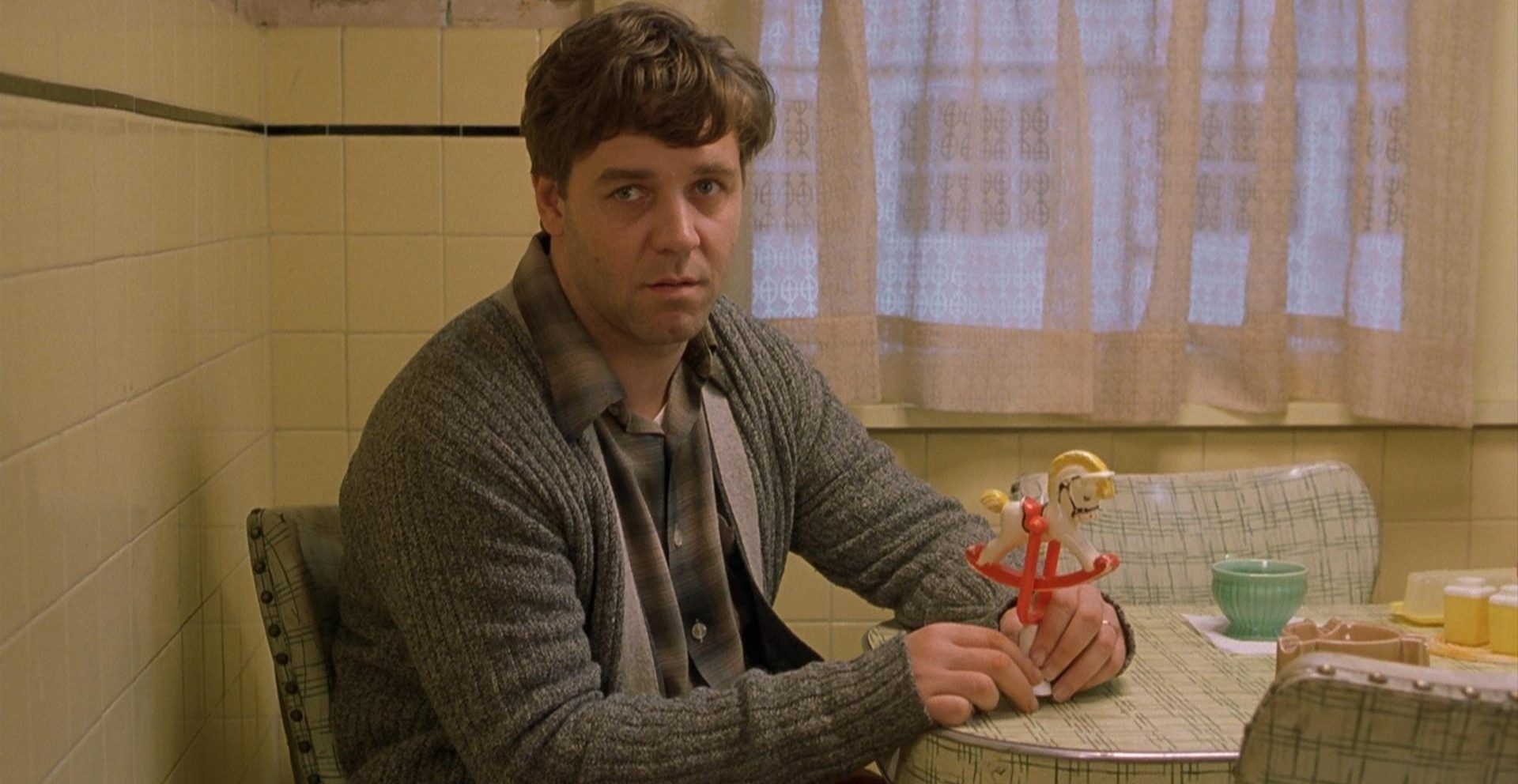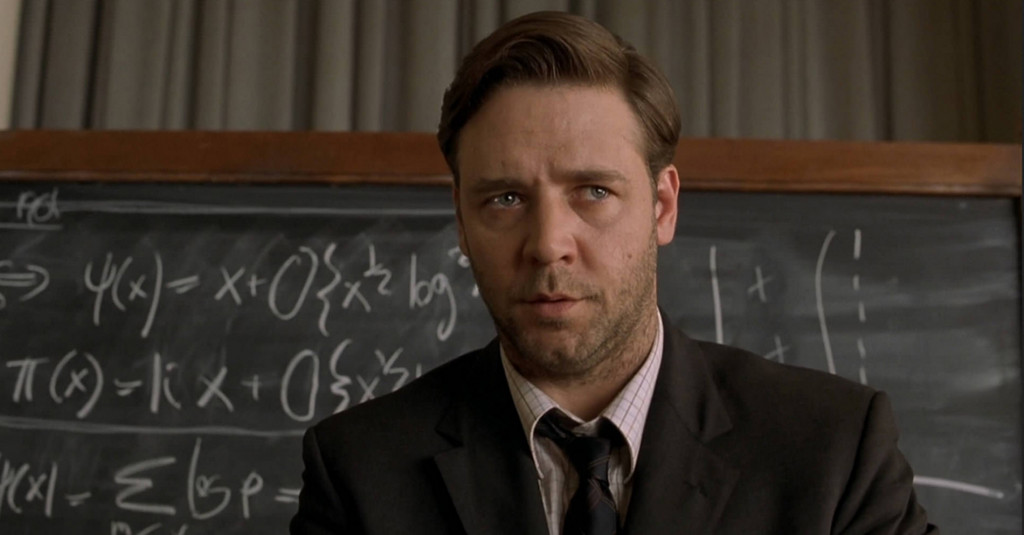After critically acclaimed masterpieces like ‘Splash (1984)’ and ‘Apollo 13 (1995)’, recognized director Ron Howard decided to take his audiences on an emotional rollercoaster with the release of his 2001 biopic ‘A Beautiful Mind’. The Oscar-winning film traces the journey of John Forbes Nash, a genius Nobel-prize-winning economist and mathematician who struggles to come to terms with schizophrenia. From a slightly arrogant and struggling mathematician who arrives at Princeton hungry for recognition to the torn and devastated man coming to terms with a mental illness, his journey is beautifully captured in critical phases throughout the film.
With Russell Crowe at the helm, famous for his roles in ‘Gladiator (2000)’ and ‘Les Miserables (2012)’, and with strong support from Jennifer Connelly as Alicia, Nash’s wife, and Ed Harris, the movie captures emotions well. Howard’s depiction of paranoid schizophrenia and the dominant themes of love, support, and ways of overcoming grief in the life of another tortured genius also raised plenty of questions about the authenticity of the narrative.
A Beautiful Mind Based on the Life of Nobel Prize-Winning Mathematician
‘A Beautiful Mind’ is partially based on a true story. It is inspired by the unauthorized biography of the same name on genius mathematician John Nash, written by journalist Sylvia Nasar. Even if it is based on the real Nash, who unfortunately passed away in a car accident in 2015 with his wife Alicia, the writer Akiva Goldsman has still taken some creative liberties with the narrative to make it more appealing to the audience, which has been criticized by a few. While the parts about his Nobel prize, his contributions to the game theory and his wife are true, there are plenty of digressions and inconsistencies witnessed in the narrative provided in the biography and the dramatic depiction of his life in the movie.

An example of the inconsistencies is his strained relationship with his wife Alicia, who is shown as the pillar of support for Nash in the movie. In reality, the couple got married in 1957 and got divorced in 1963. Alicia was an inspiring physicist who eventually did remarry John in 2001 before the movie was released, but no such conflict has been depicted in the movie, which shows the couple together till the very end. The movie also doesn’t mention that before marrying Alicia, Nash had a child with a nurse, Eleanor Stier. The child, also named John, was later put in foster care since Nash did not wish to be associated with them at that point.
Nasar’s biography also mentions Nash’s infatuation with other men, which were either one-sided or, in one case, even mutual. Critics feel that this aspect of Nash’s life should also have been included in the movie about him. Some other critical factual inconsistencies pertain to his hallucinations, which were shown to be very convincing in the movie. Nash constantly hallucinated about Pentagon official William Parcher (Ed Harris), his Princeton roommate Charles (Paul Bettany) and his niece Marcee (Vivien Cardone).
Since Marcee never seemed to grow old, Nash realized at this point in the movie that there might be some truth to what his psychologist, Dr. Rosen, played by Christopher Plummer, was trying to explain. Moreover, while the movie depicted any defence-related work done by Nash as a hallucination, an article by The Guardian suggests that Nash did take up some consultancy work for RAND Corporation, associated with national security research and not directly associated with the Pentagon.

In terms of his hallucinations, while the symptoms and the stigma attached to such conditions are depicted accurately in the movie, in reality, John Nash mostly suffered from auditory delusions, and the use of imaginary figures depicted here might be more due to the need of depicting the struggles of someone dealing with schizophrenia more accurately than the exact storyline of the kind of delusions John Nash actually suffered. Other slight factual errors in the movie have been added by the filmmakers to create an impact.
One of the most powerful scenes of the film, when the professors at Princeton present their pens at the end to Nash in acknowledgment of his accomplishments, was added for dramatization. This is not, in fact, any custom followed by Princeton professors. Even the moving Nobel Prize speech, which Nash dedicated to his wife, was not factual. Nash, in reality, was already divorced at the time he received the award in 1994 and just accepted it instead of providing any speech. With regard to his medication, the biography claims Nash did not take it after 1970. This is also depicted in the movie when he starts hiding his medication and gets hallucinations again.
At one point, he decided to live his life without the medication with full support from Alicia. Nonetheless, in the closing scene at the university, he claims to be taking newer medications that keep his condition in check. This particular line has been inserted by the director to let the audience know how important medication is for patients and that they shouldn’t get inspired to stop it. The story finally concludes with Nash coming to terms with his condition and accepting it as a part of his reality, which is what his story is about. ‘A Beautiful Mind’, therefore, seems to capture the essence of Nash’s life story, but also leaves out some important factual instances for the sake of creativity.
Read More: 10 Movies Like A Beautiful Mind You Must See


You must be logged in to post a comment.